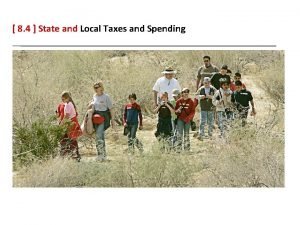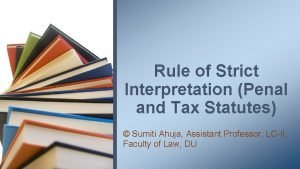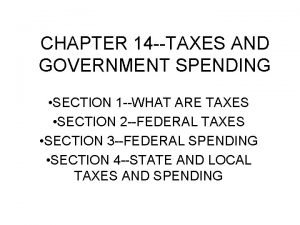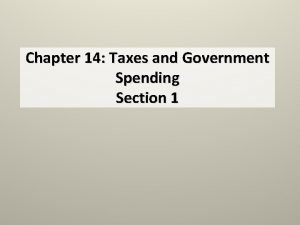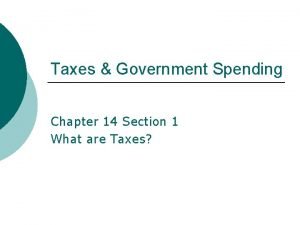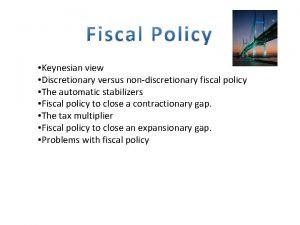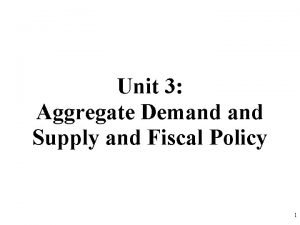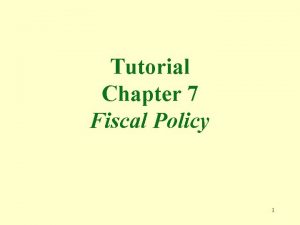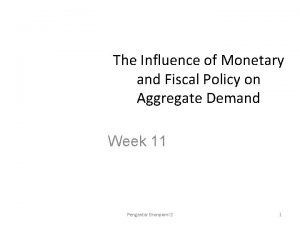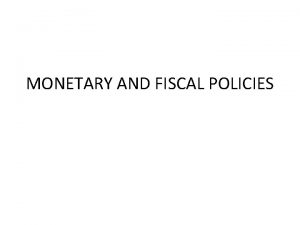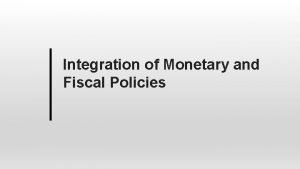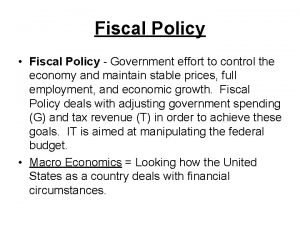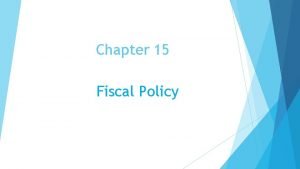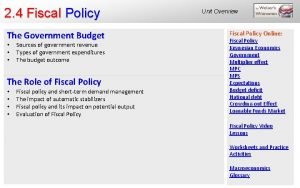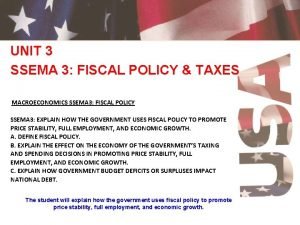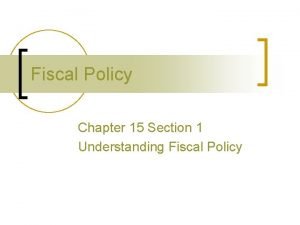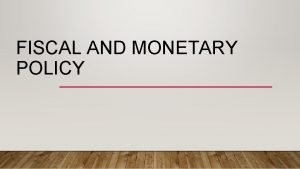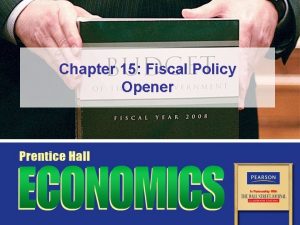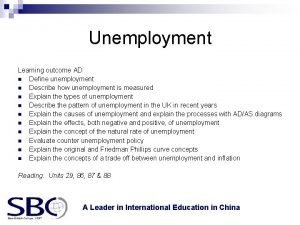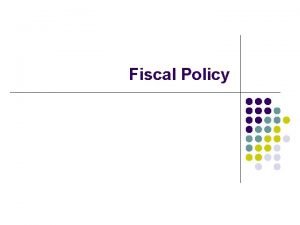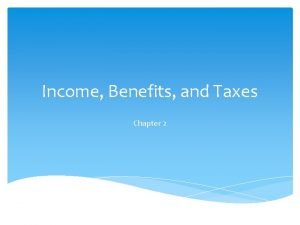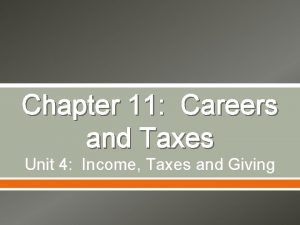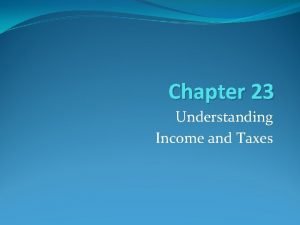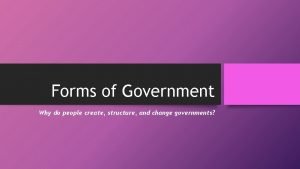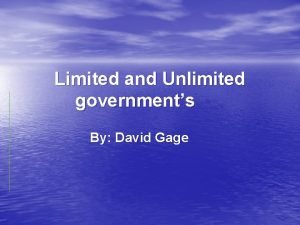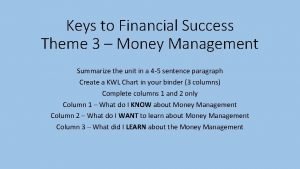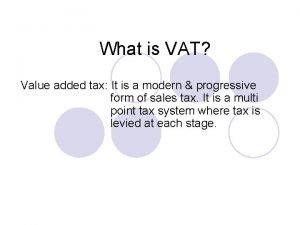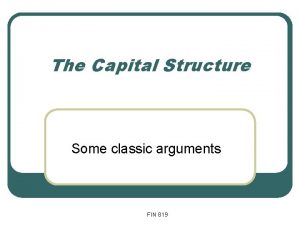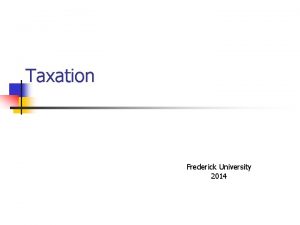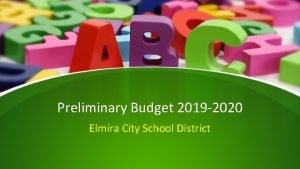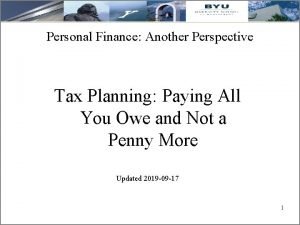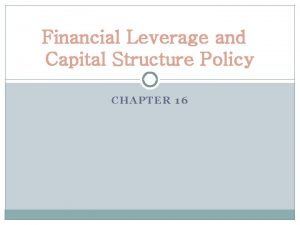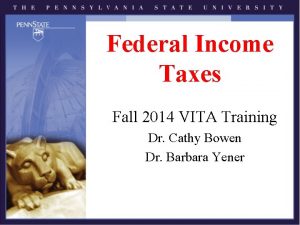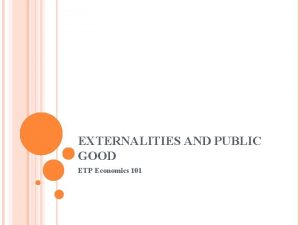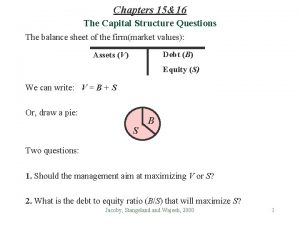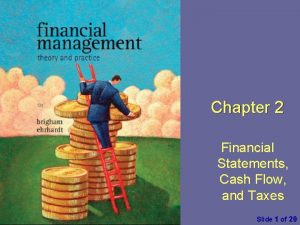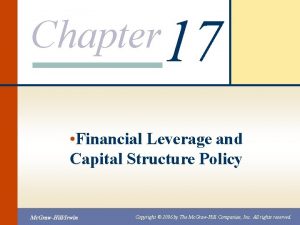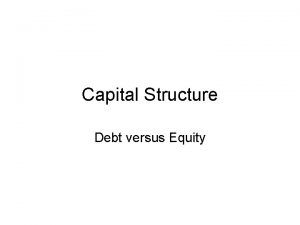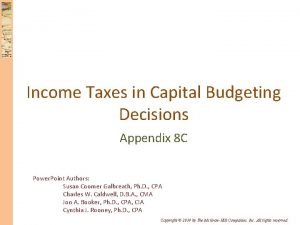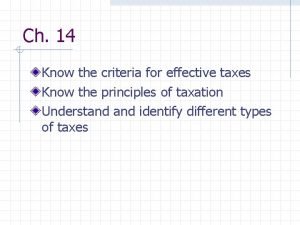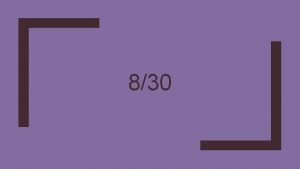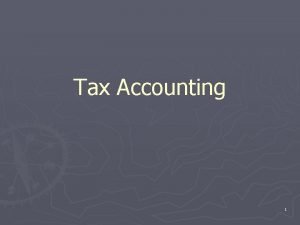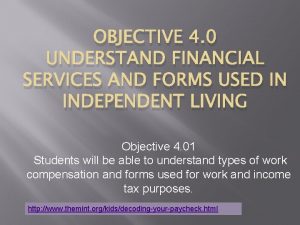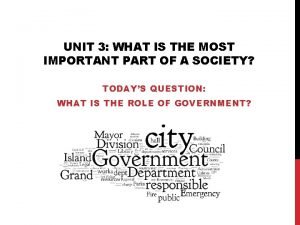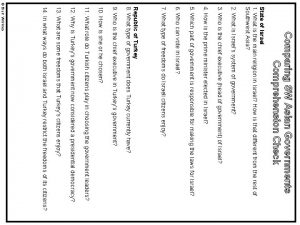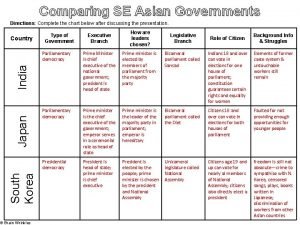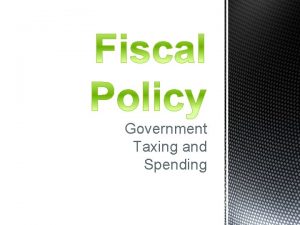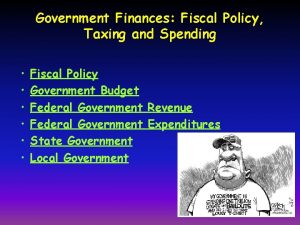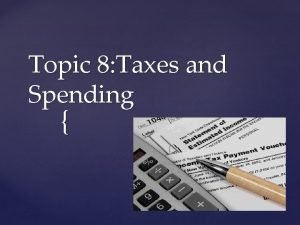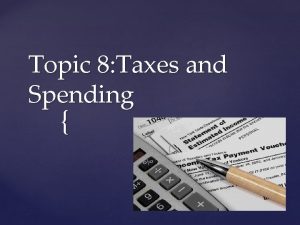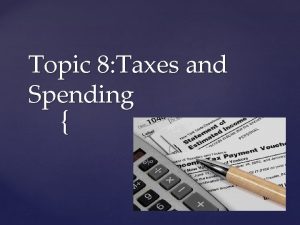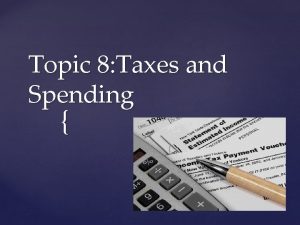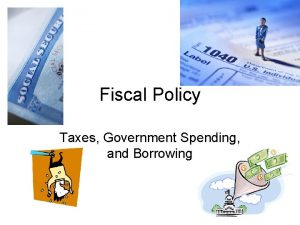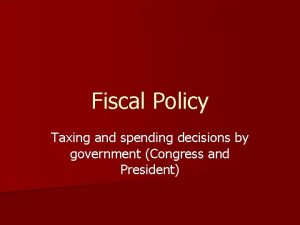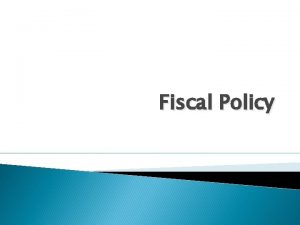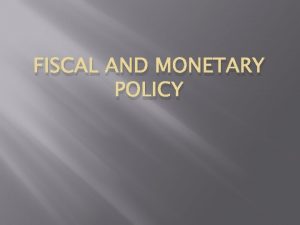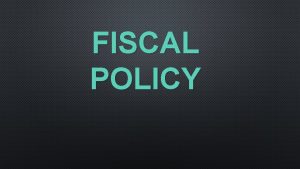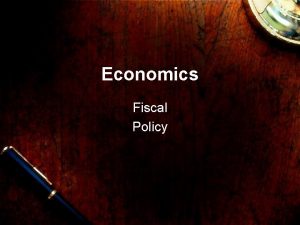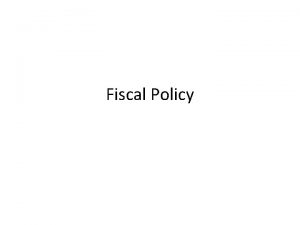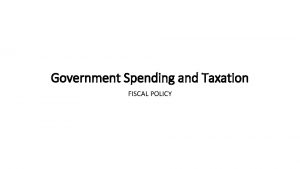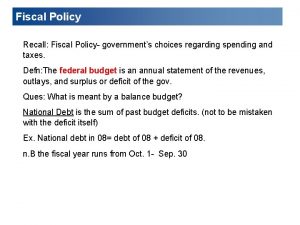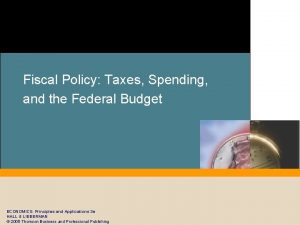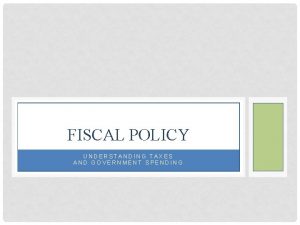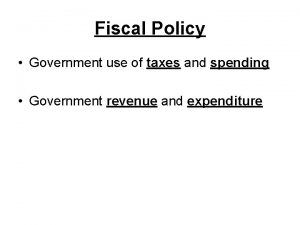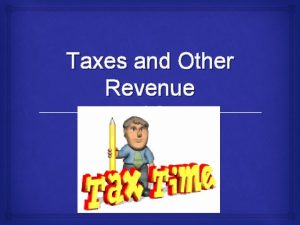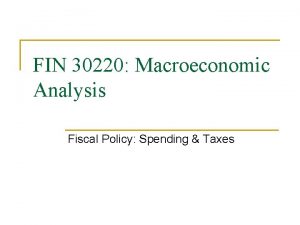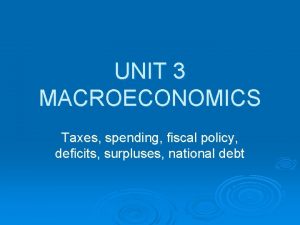Governments Taxing and Spending Fiscal Policy Taxes Part

























![Texas Tax Revenue [mainly regressive] Oil production 2% r. su % In s 4 Texas Tax Revenue [mainly regressive] Oil production 2% r. su % In s 4](https://slidetodoc.com/presentation_image/58ba4ad833b1402e2c838bb192b0a4fb/image-26.jpg)
























































- Slides: 82

Government’s Taxing and Spending (Fiscal Policy)

Taxes Part I

Taxes Objectives: In this lesson, students will be able to identify the types of taxes that exist and difference between, proportional, progressive, and regressive income taxation. Students will be able to identify and/or define the following terms: Taxes Tax Rate Revenue Expenditures Level of Government Tax Freedom Day Taxes Tax Base Types of

Taxes We Didn’t Have 100 Years Ago Accounts Receivable Tax Building Permit Tax CDL license Tax Cigarette Tax Corporate Income Tax Dog License Tax Excise Taxes Federal Income Tax Federal Unemployment Tax (FUTA) Fishing License Tax Food License Tax Fuel Permit Tax Gasoline Tax (currently 44. 75 cents per gallon) Gross Receipts Tax Hunting License Tax Inheritance Tax Inventory Tax IRS Interest Charges IRS Penalties (tax on top of tax) Liquor Tax Luxury Taxes Marriage License Tax Medicare Tax Personal Property Tax Real Estate Tax Service Charge Tax Social Security Tax Road Usage Tax Recreational Vehicle Tax Sales Tax School Tax State Income Tax State Unemployment Tax (SUTA) Telephone Federal Excise Tax Telephone Federal Universal Service Fee T ax Telephone Federal, State and Local Surcharge Taxes Telephone Minimum Usage Surcharge Tax Telephone Recurring and Nonrecurring Charges Tax Telephone State and Local Tax Telephone Usage Charge Tax Utility Taxes Vehicle License Registration Tax Vehicle Sales Tax Watercraft Registration Tax Well Permit Tax Workers Compensation Tax • Once again, none of these taxes existed 100 years ago. Then, America was the world's wealthiest nation. Then, we had no national debt. Then, we had a thriving economy that was the envy of the free and developed world.

Taxes A tax is a required payment to the government Taxation is the primary way that the government collects money. Taxes give the government the money it needs to operate. Tax Rate (in tax brackets) is the percent of income taken by the government (as taxes). The income received by the government from taxes and other nontax sources is revenue. Without revenue from taxes, the government would not be able to provide the goods and services that we not only benefit from , but that we expect the government to provide (highways, education, national defense, law enforcement, etc. ). All of these goods/services cost money – in worker’s salaries, in materials, in land labor. All members of our society share these costs through the payment of taxes. 1

Tax Structures The government decides how to structure the tax on a particular tax base (such as, based on income, property, good, or service that is subject to a tax). Economists describe three different tax structures: Proportional, Progressive, and Regressive Taxes. 2

Three Tax Structures 3 1. Proportional 2. Progressive 3. Regressive Proportional Flat Tax -applies the same tax rate to every taxpayer regardless of income bracket. . Everyone pays taxes at the same rate (%), whatever the income level. Sometimes it is called a flat tax (on income). Examples: Social Ins. (FICA), Medicare Tax, & Customs Duties. Progressive People pay a higher % rate as their income levels rise. Examples: Personal Income, Corporate Income, Estate Tax, & Gift Tax. Regressive Takes a larger % of income paid in taxes from low income groups (and less % of income when income increases). Flat Tax on Products. Examples: Property, Excise and Sales Tax.

Who Pays What Percentage of Federal Income Taxes ? Most people in the United States think that wealthy people do not pay their fair share of taxes. Do you think this is the case? Before you answer, you need to get some idea of what wealthy Americans pay in taxes compared to what they earn in income. (p. 373)

Do the rich pay their fair share of the taxes? And why is it the rich who always benefit from tax cuts?

Tax Rate is the percent of income taken by the Government. Top 1%[1, 286, 000] ($603, 000+) paid 37% of all Ave. Tax Rate taxes–average 24% Top 5%[6, 430, 000] ($137, 000+) paid 57% - average 21% Top 10%[12, 861, 000] ($99, 000+) paid 68% – average 18. 5% Top 25%[32, 152, 000] ($60, 000+) paid 85% – average 15% Top 50%[64, 305, 000] ($30, 000+) paid 97% – average 14% Bottom 50%[64, 305, 000] (<$30, 000) paid only 3. 3% of all taxes. There are 469 billionaires, [793 in world]. There are 9. 2 millionaires. There are 40 millionaires in the U. S. Senate. 4

Suppose that every day, ten men go out for drink and the bill for all ten comes ten drink to $100. If they paid their bill the way we pay our taxes, it would go like this: $100 taxes this ØThe first four men (the poorest) would pay nothing. men nothing ØThe fifth would pay $1. $1 ØThe sixth would pay $3. $3 ØThe seventh would pay $7. $7 ØThe eighth would pay $12 ØThe ninth would pay $18 ØThe tenth man (the richest) would pay $59. man $59 So, that's what they decided to do. The ten men drank every day and seemed quite happy with the arrangement, until one day, the owner threw them a curve. 'Since you are all such good customers, he said, “I'm going to reduce the cost of your daily drink by $20 Drinks for the ten now cost just $80. ” $80 The group still wanted to pay their bill the way we pay our taxes so the first taxes four men were unaffected. They would still drink for free. men free But what about the other six men - the paying customers? How could they divide the $20 windfall so that everyone would get his 'fair share? ' They realized that $20 divided by six is $3. 33. But if they subtracted that from $3. 33 everybody's share, then the fifth man and the sixth man would each end up being paid to drink his drink

So, the owner suggested that it would be fair to reduce each man's bill by roughly the reduce each man's bill by same amount, and he proceeded to work out the amounts each should pay. ! And so: same amount The fifth man, man like the first four, now paid nothing (100% savings). ØThe sixth now paid $2 instead of $3 (33%savings). 33%savings ØThe seventh now pay $5 instead of $7 (28%savings). 28%savings ØThe eighth now paid $9 instead of $12 (25% savings) savings ØThe ninth now paid $14 instead of $18 (22% savings) savings ØThe tenth now paid $49 instead of $59 (16% savings). savings ØEach of the 6 was better off than before. And the first 4 continued to drink for free. off free But once outside the restaurant, the men began to compare their savings. 'I only got a dollar out of the $20, 'declared the sixth man. He pointed to the tenth man, ' but he got $10!‘ 'Yeah, that's right, ' exclaimed the fifth man. 'I only saved a dollar, too. It's unfair that he got ten times more than I!‘ 'That's true!!' shouted the 7 th man. 'Why should he get $10 back when I got only two? The wealthy get all the breaks!' 'Wait a minute, ' yelled the first four men in unison. 'We didn't get anything. The system exploits the poor!' The nine men surrounded the tenth and beat him up. up The next night the tenth man didn't show up for drinks, so the nine sat down and had drinks without him. When it was time to pay the bill, him pay the bill they discovered something important. They didn't have enough money between all of them for even half of the bill! bill And that is how our tax system works The people who pay the highest taxes get the most benefit from a tax reduction Tax them too much, much attack them for being wealthy, and they just may not show up anymore In fact, they might start drinking overseas where the atmosphere is somewhat friendlier

What is a Fair Share? Most people believe that everyone should pay his or her fair share of taxes. The two following Principles of Taxation are used to judge fairness. :

1. Two Principles of Taxation Benefits-received Principle says that people who benefit bear its cost. The more they use, the more they pay. (gasoline taxes, tolls, cigarettes, alcohol) This is a consumption tax. EXP: Government spends money to maintain and take care of our roads and highways. Gas tax revenues (excise taxes) are used to take care of roads. The more some one uses roads and highways, the more that person pays in gas tax revenues. So, the major users of roads and highways pay most of the cost of keeping up roads and highways. 5

2. Two Principles of Taxation Ability-to-Pay Principle says that people with more income or wealth should pay more taxes because they have the ability to “bear the burden. ” burden It doesn’t make any difference what benefits or services they receive. Ability-to-Pay Principle based on INCOME – wages & salary, or any other payments. Will pay based on their total dollar amount. EX: Fed Income Tax Ability-to-Pay principle based on WEALTH –people with more assets (houses, stocks, bonds) would pay taxes based on the total value. EX: Inheritance and estate taxes, property taxes, and capital gains. 6

Taxes There are three level of government: Federal State Local 7

Taxes- Federal There are four tax categories at the Federal level. 1. Personal Income Tax – 45% of federal revenue. This U. S. had no individual income tax until 1913. This is a progressive tax on an individual’s total income based on ability-to-pay. (Tax Rate: 10%, 15%, 28%, 33% and 35%). Dependents living with parents pay no tax up to $5, 700. Some individuals pay both federal and state income tax because their state has as a personal income tax – Thankfully, Texas does not! 8

Taxes- Federal 2. Corporate Income Tax – (12%) The taxes levied on a business corporation's profits. This is a progressive federal tax. (Some may pay both Federal & State tax. ) Corporate Tax Rates: Under $50, 000 $75, 001 - $100, 000 100, 001 - $335, 000 $335, 001 - $10, 000 $10, 001 - $15, 000, 001 – $18, 333, 334 + 15% 25% 39% 34% 35% 38% 35% (Most pay 35% 9

Taxes- Federal 3. Social Security Tax – (36%) FICA - Federal Insurance Contribution Act (7. 65% for both Social Security and Medicare)- this is a tax on employment income Half the tax the placed on the employer and the other half on the employee. • (A) Social Security Tax (6. 2%). It is proportional up to $106, 800, then it becomes regressive because no tax after $106, 800. (A person making $106, 800 pays 6. 2%; a person making $312, 600 only pays 3. 1 of income. ) • (B) Medicare Tax (1. 45) – on every dollar earned. This is proportional tax up to $200, 000, then 2. 35% above $200, 000. 10

Taxes- Federal 4. Other Taxes – (7%) of Federal Budget. (A). Excise Tax – a specific tax on the production of particular products (not levied on the individual’s income). Excise taxes are regressive because they take a larger % from low income groups. Excise taxes are levied on specific products like: gasoline, liquor, telephone services, tires, legal betting, and coal. (B). Estate Tax-tax levied on the assets of a person who dies and has assets in excess of $3. 5 million dollars. Estate taxes range from 18 -50% of the value of the estate which makes this tax a progressive one. This tax is supposed to disappear in 2010 but reappeared in 2011. continued 11

Taxes- Federal 4. Other Taxes – (7%) (C). Gift Tax– Tax tax placed on the transfer of certain gifts of value, such as money ($13, 000 or more) or other personal property. The person who gives the gift pays the gift tax. It also is progressive up to 50%. (D). Customs duties (tariffs)-tax on imported goods. It is proportional. Although they produced most of government revenues prior to 1913, they produce very little revenue today due to free trade. During George Washington’s time, tariffs brought in over 99% of the government’s revenue. 12

Federal Four Revenue is from Major Taxes Personal Income Tax Corporate Income Tax Social Security Tax Other Taxes 7% Revenue for 3 Major Taxes $2, 524 Billion Source: U. S. Bureau of Census All Other 12% 36 % Social Security Tax Interest 9% 45% Personal Income Tax Health 24%12 % Corporate Tax Largest sector is Personal Income Tax 13

State and Local Taxes The three most important state and local taxes are the sales tax, property tax, and individual income tax. 1. Sales Tax – a regressive tax levied or added to the price of most products (books/cars). The sales tax is not levied on baby clothing, food, and medicine. Example: Sales tax is Dallas is 8 ¼ % of every dollar. Only 5 states, Alaska, Delaware, Montana, New Hampshire, and Oregon – do not have sales tax. Texas has a 6 ¼ % sales tax. EXP: Palestine 6. 25 + City Tax 1. 50 + County Tax. 50 = 8. 25% within the Palestine City Limits. (On average, a family of four, pays about $800 a year on sales tax. ) 14

State and Local Taxes 2. Property Tax- taxes on the value of property (mainly on houses and buildings). There taxes are also on furniture, autos, farm animals, stock, bonds, and bank accounts. They finance education, police and fire protection. This tax is a regressive one because if two people own separate $100, 000 homes , they both pay the same tax. Major state/local revenue. 3. State Individual Income Tax – tax on an individual’s total income Texas is one of 7 states with no state individual income tax! (States use different methods for figuring their state tax. ) 2 15

The Seven States With No State Income Tax *They tend to have more regressive tax systems.
![Texas Tax Revenue mainly regressive Oil production 2 r su In s 4 Texas Tax Revenue [mainly regressive] Oil production 2% r. su % In s 4](https://slidetodoc.com/presentation_image/58ba4ad833b1402e2c838bb192b0a4fb/image-26.jpg)
Texas Tax Revenue [mainly regressive] Oil production 2% r. su % In s 4 xe l Ta ra u % at 5 N as G Bus. fr Tax anchi 9% se Motor Fuels 11% (R) es l Sa lic ) o h R e co % ( l cl ) i A. 2 h (R v e e V b or 0% t 1 o M Sales Tax (R) 61% *Texas gets most of its revenue from the sales tax. 16

What is AMT Tax Alternative Minimum Tax an alternative tax system designed so everyone pays at least a minimum tax. It is a tax that some people have to pay on top of their regular income tax. The only people who are subject to AMT tax are those who are above a certain income. Example: In 2014, that income was $70, 950 for a married couple filing jointly. Recently more people are falling under this tax due to increased inflation. 17

What is Value-Added Tax? VAT Tax is a multistage tax collected from firms at each stage of the production and distribution process. (Example below showing 10% VAT at each stage) 18


How Long Do You Have to Work to Pay All Your Taxes ? In 2014, the average person had to work from Jan. 1 to April 21, before earning enough to pay all taxes owed-assuming that all income went toward taxes. (Not the same for all states because taxes are different. ) This year the Tax Freedom Day was 3 days longer than the year before (April 23 rd ). See Text, page 372 for more Information, if needed. Tax Freedom Day 19

Don’t Forget about Tax Breaks A tax break - is a term referring to any item which avoids taxes, including any tax exemption, tax deduction, tax credit, or even a "tax loophole“. Tax breaks are give in order to promote certain activities that deem beneficial to society. (Example: deduction for home mortgage interest when filing personal income tax. Promotes home ownership. ) Americans pay about 29 cents of every dollar in taxes. When government issues a tax break, it chooses to give up tax revenue (functions as government expenditure). Both spending and tax breaks result in the same outcome – less money in the U. S. Treasury. Tax breaks in the 2015 budget are expected to cost the federal government $1. 24 trillion (in discretionary spending). 20

Tax cheating amounts to about $310 billion a year. Who cheats the most? Self-employed people who are in charge of their own taxes like gardeners, carpet layers, who get paid in cash. Others are auto dealers, barbers, telemarketers, restaurant owners, accountants, doctors, and lawyers. Many overstate deductions. Over 60% corporations paid zero taxes 1996 -2000. Men cheat more than women. In 1987, the IRS began requiring taxpayers to report the SSN of all dependents. The next year 7 million children vanished(9%). People were listing their dogs, cats and birds as dependents. Only about 20% of the disappearing dependents represented children who had been claimed by both parents after a divorce. Informers on tax cheaters can get you 1% of what 21 they collect or 10% if you provide paperwork. of from

Wrap Up

Review – True/False 1. There are 4 major taxes categories at the federal government level: federal, state, local, and, municipal. False –Personal Income, Corporate Income, SS Tax, Others 2. The federal government and some states apply an excise tax on some items. True 3. The AMT (alternative minimum tax) is a tax that everyone pays on top of their regular income tax. False (only applies to people above a certain income) 4. With a proportional income tax, everyone pays at the same rate. True

Review – True/False 1. Personal Income Tax is a federal government tax placed on income from employment. False – the is Social Security Tax 2. A Regressive Tax takes a larger percent of income paid in taxes from low income groups. True (sales tax and excise tax works this way) 3. Proportional Income Tax is a tax that everyone pays at the same rate, whatever the income level. True 4. A tax placed on the value added to each stage of production and distribution is called excise tax. False – Value-Add Tax (VAT)

Review – True/False 1. The money government receives from taxes is called “federal payments”. False – revenues 2. The VAT (Value-added Tax) is tax collected for the value of property, such as, homes and businesses. False (VAT is multistage tax collected from firm at each stage) 3. Texas gets most of its tax revenues from sales tax. True 4. Most of the federal revenues comes from corporate tax. False – from Personal Income Tax 5. A tax break is any item that avoids some taxes and reduces money going to the U. S. Treasury. True

Review – True/False 1. Corporations may be required to pay tax on their profits to both the federal and state government. True 2. Sales tax usually does not apply to baby clothing, food, and medicine. True (small tax on some foods in few states) 3. The average person spends one month our of each year working to pay his/her taxes for the year. False (usually 4 -5 months – called: Tax Freedom Day) 4. A progressive tax is similar to a flat tax. False – Proportional tax- Flat Tax applies the same tax rate to every taxpayer regardless of income bracket. 5. All taxes are based on the benefits-received principle. False (either benefits-received or ability–to-pay) END

Government’s Spending (The Budget) Part 2

The Budget: Deficits and Debt Objectives: In this lesson, students will be able to describe how the federal government spends its tax revenues, and describe some of the issues connected with budget. Students will be able to identify and/or define the following terms: Revenue Mandatory Expenditures Discretionary Balanced Budget Surplus Budget Deficit

The Budget The basic tool of fiscal policy is the federal budget. It is made up of two fundamental parts: Revenue (income from taxes) and Expenditures (spending programs). When the federal government’s revenues equal its expenditures , the federal government has a balanced budget In reality, the federal budget is almost never balanced. Usually, it is running a surplus or a deficit. 22

The Budget A budget surplus occurs in any year when revenues exceeds expenditures (more money going into the Treasure than coming out of it). A budget deficit occurs in any year when expenditures exceed revenues (there is more money coming out of the Treasury than going into it). 23

What Are the Federal Governments Expenditures? In 2016, the proposed federal government will spend $3. 99 trillion. These trillions of dollars make up a considerable chunk – 21% of the GDP- of the economy. That means that expenditure, government spending , makes up a sizable share of all money spent in the U. S. each year> So, where does all the money go? 24

What Are the Federal Governments Expenditures? 3 Categories of Government Expenditures: 1. “Mandatory Spending” refers to money that lawmakers Spending are required by existing laws to spend on certain programs - takes about 2/3 of the entire budget. (Must change law to 2/3 change spending - may be politically hard to do. ) 2 “Discretionary Spending” is the spending about which Spending government planners can make a choice – 1/3 of the budget. 1/3 3. “Interest on Federal Debt” – Interest on accumulated Debt debt, minus interest income from assets government owns. The “Fiscal Year” begins Oct. 1 st of the year preceding Year and runs through Sept. 30 of current year. 30 25

Expenditures for 2016 – 3 Main Categories Fiscal Year: 2016 Discretionary Gov. planners can choose how to spend. 29% 65% 6% Mandatory Gov. planners are required by law to spend on specific items Interest Spending Interest on accumulated debt. $3. 99 trillion (100% of Expenditures) Includes Mandatory, Discretionary, & Interest Spending 26

The U. S. Government’s Total Revenue Is Estimated To Be $3. 525 Trillion for Fiscal Year 2016 OOPS! Gov. Revenue of $3. 5 T minus Spending $3. 9 T = a Budget Deficit. It will be highest revenue ever received by the U. S. Government. It’s more than was collected in the first 180 years of our country’s history. 27

Expenditures for 2016 - 3 Main Categories-Itemized Fiscal Year: 2016 Expenditures for 2015 – 3 Main Categories- Itemized Budget - $3. 99 trillion (100% of Expenditures) Itemized Categories of Mandatory, Discretionary, & Interest Spending

2016 - Mandatory Spending Only Fiscal Year: 2016 Most of the Mandatory Expenditures are for Entitlements 2016 - $2. 54 trillion (65% or 2/3 of Budget) Mandatory Expenditures 28

Entitlement – Programs or benefits using established eligibility requirements to provide health, nutrition or income supplement's to individuals. Growth of Entitlements: This is the largest and fastest growing part of the deficit. Reduction cannot be accomplished unless law is changed or altered. Because millions of Americans are supported by entitlements, a change to reduce the deficit would be difficult. 29

2016 – Discretionary Spending Only 2015 Fiscal Year: 2016 - $1. 16 trillion (29% or about 1/3 of Budget) Discretionary Expenditures 30

The U. S. Government Has A Budget Deficit for Fiscal Year 2016 of $474 Billion Budget Deficit: Government spending is greater than tax revenues. Look at previous years: Deficits • • FY 2014 - $649 billion. FY 2013 - $680 billion. FY 2012 - $1. 087 trillion. FY 2011 - $1. 299 trillion. FY 2010 - $1. 294 trillion. FY 2009 - $1. 413 trillion. FY 2008 - $459 billion. FY 2007 - $161 billion. Notice what happened to the budget when the recession hit in 2009. Huge deficits were a result of 4 factors: 1. Economic stimulus package that cut taxes and extended unemployment benefits, and funded publics works projects to create jobs and kick-start the economy. 2. The recession reduced Federal income, the economy tanked. Gov. revenues down. 3. Attack on 9/11. Fed Gov. increased military spending “War on Terror”. 31 4. Mandatory spending increased.

The U. S. Government’s Total Revenue for 2016 Is Estimated To Be $3. 525 Trillion Revenues from last few years: 2015 2014 2013 2012 2011 2010 2009 2008 $3. 337 Trillion $3. 002 Trillion $2. 775 Trillion $2. 450 Trillion $2. 300 Trillion $2. 160 Trillion $2. 100 Trillion $2. 520 Trillion Recession started in 2009. 2007 financial crises started. Tax revenues fell off, but are now rising because the economy is improving. If the economy turns out to be weaker than expected, tax collection could go down & unemployment compensation might rise. In this case the deficit would go up; for a stronger economy, federal revenues would go up and deficit cut. 32

A packet of one hundred $100 bills is less than 1/2" thick and contains $10, 000. Fits in your pocket and is more than enough for 2 weeks of fun. This next little pile is $1 million dollars (100 packets of $10, 000). You could stuff that into a grocery bag and walk around with it.

While a measly $1 million looked a little unimpressive, $100 is a little more respectable. It fits neatly on a standard pallet. . . And $1 million BILLION dollars. . . now we're really getting somewhere. . .

Next we'll look at ONE TRILLION dollars. This is that number we've been hearing so much about. What is a trillion dollars? Well, it's a million thousand billion. A one . It's a followed by 12 zeros $1, 000, 000 (And notice those pallets are double stacked. )

History – Budgets: Balanced and Deficit Before the Great Depression (1929 -1933), most people believed that the federal budget should be balanced. In other words, government spending should equal tax revenues. However, the economic downturn of the Great Depression made people doubt this belief. Many people came to see budget deficits as necessary, given the high unemployment in the economy. 33

History – Budgets: Balanced and Deficit According to most people, the choice was simple: (1) Keep the federal budget balanced and suffer high unemployment (along with reduced output of goods and services) or (2) Accept the budget deficit and reduce the unemployment rate. Every time the federal government runs a deficit, it has to borrow money (sell Treasury bonds/notes) and incur a debt. Each yearly deficit is added to the current accumulated U. S. debt. This accumulated federal debt is called the National Debt, (or the total amount of money the federal government owes. ) 34

History – Budgets: Balanced and Deficit When the government borrows money because of budget deficits, it has to borrow money from people (also called public debt- because bonds/notes are sold to the public. The part of the debt U. S. citizens owe is private debt. ). This debt (IOU’s) will have to be repaid one day. Taxes must be used to pay off the government’s national debt. (Remember, 2016 budget includes current “Interest on Debt” of 6%. ) 35

History – Budgets: Balanced and Deficit So, in the future, when the debt has to be repaid, taxes have to be higher than they would have been if there were no debt. Current budget deficits are a form of “taxation without representation” for future taxpayers. 36

To Whom Does the U. S. Government Owe Money Overall, U. S. entities own 66% Foreign entities own 34% U. S. Owes $19 Trillion as of Jan. 2016 The United States has the largest debt of any country in the world. We pay for our debt by selling Treasury bills, Notes, and Bonds. The debt is nearly as much as our country produces in a whole year. It will have to be paid back one day by the next generations of citizens. In 2016, we added $283 Billion. 37

$19 Trillion $9 trillion $8 trillion $7 trillion Est. population is 319, 555, 529. Each person owes over $56, 000. each. National Debt increases on an average 2. 42 billion per day since Sept. 2012. 38

How can we balance the Budget ?

Two Ways To Balance The Federal Budget 1. Increasing government revenues (use fiscal policy) a. Increase taxes b. Decrease in government expenditures[$3. 9 tr. in 2015] Tax cheating cost the government over $310 billion 2. Government must stop waste and fraud a. A check of 4 states (including TX) turned up 26, 000 dead people getting food stamps, costing $1. 5 B a year. b. Thousands of prisoners get welfare 60, 000 inmates were getting $500 million in fraudulent benefits 12, 000 inmates were receiving illegal food stamps On “Dateline” a report said that $53 M was caught as prisoners were filling out W-2 forms, as if they had jobs, trying to get refunds. $10 M got through. c. There was $98 billion in waste & fraud in 2009. There is $48 billion fraud [out of $400 B] in Medicare 39 Federal employees each year charge millions of dollars for such things as internet dating, tailor-made suits, lingerie, lavish dinners to their government credit cards. Last year, for purchases over $2, 500, about half were improperly received.

1. 2. 3. 4. 5. 6. Deficit Related Problems We could have a constitutional amendment to balance constitutional amendment the budget. However, this could effect the business cycle fluctuation and destabilize the economyno money to spend during a recession. Gramm-Rudman-Hollings Act – balance the budget by 1991(revised to 96). The Supreme Court later ruled it unconstitutional. (Someone tried!) Tax Increases – Perot wanted to raise gasoline taxes 50 cents a gallon. (Worked in Alaska with cigarettes) Privatization – U. S. government could sell its assets. Britain sold $25 billion of government assets in the 80 s. Line-item veto – the President could veto particular portions. Supreme Court declared this unconstitutional. 40 This would get rid of “pork-barrel” (earmarked) legislation. Term Limits for congressmen and senators.

The term "pork barrel" barrel stems back to the early 1800 s when the popular meat was packed that way, and hungry farm hands reached in for slabs of salt pork. In 1879, it was adopted as political slang to mean goodies for the local district are added to a bill and are paid for by the taxpayers at large. See the following examples of “pork barrel”. 41


• $107, 000 to study the sex life of the Japanese quail. • $1. 2 million to study the breeding habits of the woodchuck. • $150, 000 to study the Hatfield-Mc. Coy feud. • $84, 000 to find out why people fall in love. • $1 million to study why people don't ride bikes to work. (MOST ABSURD PORK from 2003)

• • • $19 million to examine gas emissions from cow flatulence. $144, 000 to see if pigeons follow human economic laws. Funds to study the cause of rudeness on tennis courts and examine smiling patterns in bowling alleys. $219, 000 to teach college students how to watch television. $2 million to construct an ancient Hawaiian canoe.

• • • $20 million for a demonstration project to build wooden bridges. $160, 000 to study if you can hex an opponent by drawing an X on his chest. $800, 000 for a restroom on Mt. Mc. Kinley. $100, 000 to study how to avoid falling spacecraft. $16, 000 study of the komungo, a Korean instrument.

$1 million to preserve a sewer in Trenton, NJ, as a historic monument. $6, 000 for a document on Worcestershire sauce. $10, 000 to study the effect of naval communications on a bull's potency. $100, 000 to research soybean-based ink.

$1 million for a Seafood Consumer Center. $57, 000 spent by the Executive Branch for gold-embossed playing cards on Air Force Two. Total ABSURD PORK from previous pages: $ 45, 980, 000

And What Kind Of Pork Is In Obama’s Stimulus of 2009 $1. 8 million for pig odor research in Iowa. $950, 000 for a Convention Center in Myrtle Beach, SC. $143, 000 for a natural museum in Las Vegas. $238, 000 for the Polynesian Society in Hawaii. $2. 1 million for the Center for Grape Genetics in New York. $1. 7 million for a honey bee factory in Weslaco, TX. $1 million for Mormon cricket control in Utah. $650, 000 for beaver management in NC & MS. There are more earmarks here than on a typical Mike Tyson opponent

Causes of Budget Deficits Include: • • National emergencies Providing national defense Stabilizing the economy Promotion of economic well-being of citizens. 42

How does the Federal Debt impact the economy? • It may reduce purchasing power of economy (fewer revenues to help when needed) • It may affect the distribution of income (who pays interest on debt –rich or middle class) • It may transfer purchasing power from private to public sector (foreign debt increases public debt-interest payments leaving America. ) • If may cut down individual incentives to work and cause rise in interest rate (less money causes higher interest rates and lack of enthusiasm if income is taxed more). 43

Creating the Budget 1. Every year, the Federal agencies send requests (Department of Labor, Defense, Energy, Education…) for money to the Office of Management and Budget. The OMB is part of the Executive Office of the President. 2. The OMB works with the President to create a budget. In January or February, the President sends this budget to Congress. (continued) 44

Creating the Budget 3. Congress makes changes to the budget and sends this new budget to the President. 4. At this point, one of two thing can happen: A. The President signs the budget into law. B. The President vetoes the budget. If congress cannot get a 2/3 majority to override the President’s veto, Congress and the President must work together to create a new, compromise, budget. 27 45

Wra p Up

Review – True/False 1. If the federal government spends more than it receives in tax revenues, it has to borrow the difference and incur a debt. True 2. When overall spending exceeds tax revenues, the government has a budget surplus. False (Budget Deficit) 3. Most of the spending in mandatory spending is for entitlements. True (benefits for health, nutrition, & income supplements for those who apply and meet the criteria for eligibility) 4. The federal government has to pay interest on the national debt. True

Review – True/False 1. Creating the federal budget begins with the Board of Governors at the Federal Reserve. False (Federal agencies send requests for money to the Office of Management and Budget. ) 2. The fiscal year begins on Oct. 1 and runs through Sept. 30 of the next year. True 3. Some people may be required to pay a federal personal income tax, as well as a state personal income tax. True (but Texas does not have a state income tax) 4. The property tax is a major source of revenue for the federal government. False (Just for State government)

Review – True/False 1. The national debt represents overspending by the federal government for a one-year period of time. False (It is an accumulation of current and past year’s budget deficits. ) 2. The federal budget must be prepared and passed every two years. False (every year) 3. A balanced federal budget occurs when tax revenues equal government expenditures. True 4. The accumulation of deficits is called the national debt. True

Review – True/False 1. The government’s spending makes up a sizable share of all money spent (GDP) in the U. S. each year. True (21% in 2016 budget) 2. Taxes are used to pay off the national debt. True 3. Pork Barrel means that the President can veto any item in a bill that looks like fat (or over spending). False (political slang to mean goodies for the local district are added to a bill and are paid for by the taxpayers at large. ) 4. Most of the federal tax revenue comes from personal income tax. True End of Review

Taxes and the Budget Test

The End
 State and local taxes and spending
State and local taxes and spending Strict interpretation of taxing statutes
Strict interpretation of taxing statutes Chapter 14: taxes and government spending section 1
Chapter 14: taxes and government spending section 1 Chapter 14 taxes and government spending
Chapter 14 taxes and government spending Chapter 14 taxes and government spending
Chapter 14 taxes and government spending Loanable funds graph recession
Loanable funds graph recession Aggregate supply shifters
Aggregate supply shifters Unit 3 aggregate demand aggregate supply and fiscal policy
Unit 3 aggregate demand aggregate supply and fiscal policy Nondiscretionary fiscal policy
Nondiscretionary fiscal policy Unit 3 aggregate demand aggregate supply and fiscal policy
Unit 3 aggregate demand aggregate supply and fiscal policy Inflation
Inflation Example fiscal policy
Example fiscal policy Fiscal policy practice
Fiscal policy practice Components of fiscal policy
Components of fiscal policy Crowding out effect of fiscal policy
Crowding out effect of fiscal policy Instruments of fiscal policy
Instruments of fiscal policy Tools of fiscal policy
Tools of fiscal policy Ib economics fiscal policy
Ib economics fiscal policy Fiscal demand side policy
Fiscal demand side policy Fiscal policy to control inflation
Fiscal policy to control inflation Types of fiscal policy
Types of fiscal policy Instruments of fiscal policy
Instruments of fiscal policy Crowding out
Crowding out Demand side fiscal policy definition
Demand side fiscal policy definition Money includes
Money includes Crowding out effect of fiscal policy
Crowding out effect of fiscal policy Example of expansionary fiscal policy
Example of expansionary fiscal policy Iousa worksheet
Iousa worksheet Goals of fiscal policy
Goals of fiscal policy Fiscal vs monetary policy
Fiscal vs monetary policy Goals of fiscal policy
Goals of fiscal policy Fiscal policy
Fiscal policy Cyclical unemployment diagram
Cyclical unemployment diagram Fiscal policy meaning
Fiscal policy meaning Features of fiscal policy ppt
Features of fiscal policy ppt Fiscal policy definition
Fiscal policy definition Meaning
Meaning Chapter 2 income benefits and taxes
Chapter 2 income benefits and taxes Section 4 best practices of successful people
Section 4 best practices of successful people Chapter 23 understanding income and taxes
Chapter 23 understanding income and taxes Flow chapter 2
Flow chapter 2 Payroll tax expense journal entry
Payroll tax expense journal entry Why do people create structure and change governments
Why do people create structure and change governments How do the governments of kenya and nigeria compare?
How do the governments of kenya and nigeria compare? Is canada limited or unlimited government
Is canada limited or unlimited government John and marcia monthly spending plan 1 answer key
John and marcia monthly spending plan 1 answer key Why is evaluating and adjusting a spending plan important
Why is evaluating and adjusting a spending plan important What is vat
What is vat Mm proposition ii with taxes
Mm proposition ii with taxes How much does wanda earn per hour?
How much does wanda earn per hour? How many types of taxes are there
How many types of taxes are there Examples of progressive taxes
Examples of progressive taxes Classification of tax
Classification of tax Elmira city school district taxes
Elmira city school district taxes Understanding taxes
Understanding taxes Optimal capital structure
Optimal capital structure Fin 360
Fin 360 Understanding taxes
Understanding taxes Corrective tax
Corrective tax Mm proposition ii with taxes
Mm proposition ii with taxes Paycheck
Paycheck Total net operating capital
Total net operating capital Mm proposition ii with taxes
Mm proposition ii with taxes Advantages of debt vs equity
Advantages of debt vs equity Residential status meaning
Residential status meaning Tax russia
Tax russia Calculate income tax
Calculate income tax The effect of income taxes on capital budgeting decisions
The effect of income taxes on capital budgeting decisions 3 criteria for effective taxes
3 criteria for effective taxes People often refer to taxes
People often refer to taxes Classification of taxes
Classification of taxes Cash is current asset or not
Cash is current asset or not The colonists paid lower taxes on molasses because of the
The colonists paid lower taxes on molasses because of the Www.irs.gov/app/understanding taxes/student/simulations.jsp
Www.irs.gov/app/understanding taxes/student/simulations.jsp Difference between fas 109 and asc 740
Difference between fas 109 and asc 740 Pay with taxes
Pay with taxes Lesson 1 trouble over taxes
Lesson 1 trouble over taxes Chapter 19 intermediate accounting
Chapter 19 intermediate accounting Different kind of governments
Different kind of governments Three political problems postwar governments faced.
Three political problems postwar governments faced. Comparing sw asian governments comprehension check
Comparing sw asian governments comprehension check Comparing se asian governments answer key
Comparing se asian governments answer key Is japan a unitary state
Is japan a unitary state
